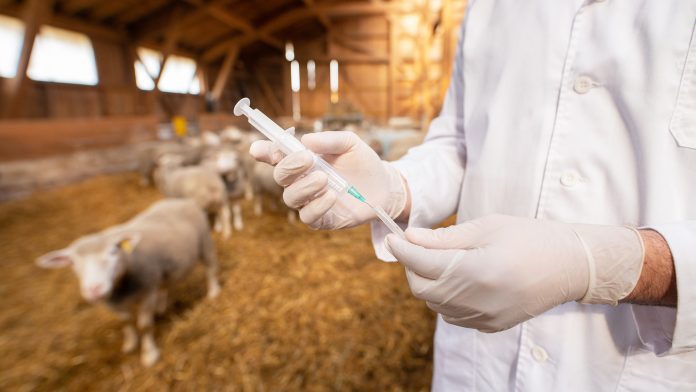
Chris Lloyd and Mary Bawn of the Responsible Use of Medicines in Agriculture (RUMA) Alliance explain how effective antibiotic use can significantly alleviate antimicrobial resistance (AMR) in the livestock sector.
The Responsible Use of Medicines in Agriculture (RUMA)1 Alliance was established in 1997 to promote the highest standards of food safety, animal health and animal welfare in the British livestock industry. It is an independent non-profit group with a unique cross-sector role comprising representatives from organisations covering all stages of the food chain from ‘farm to fork’. RUMA brings together organisations from right across the livestock supply chain and seeks to promote a coordinated and integrated approach to best practices in the use of medicines. RUMA champions the responsible use of animal medicines in UK livestock by producing specific ‘guidelines on responsible use’ and has a current focus on AMR which is coordinated through a range of collaborative activities that contribute to the UK 5 Year AMR Strategy, most notably driven through the RUMA Targets Task Force (TTF).
AMR is one of the biggest challenges facing society and the medical and agricultural sectors globally. A core part of RUMA’s role is to ensure that the UK is appreciated and recognised as a major food-producing country that adopts responsible use of animal medicines to deliver world-leading farm animal health and associated welfare. Here, RUMA’s Secretary General, Chris Lloyd and RUMA’s Communications Manager, Mary Bawn, outline to Health Europa Quarterly the significant achievements to date and strategies that the organisation is implementing to tackle AMR in the agriculture industry.
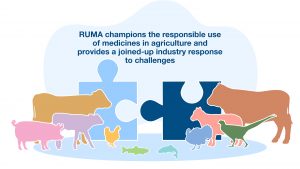
The RUMA Targets Task Force (TTF)
Lord O’Neill2 set a challenge to UK Agriculture in 2016 to respond to the AMR challenge and contribute to the UK’s One Health effort to reduce resistance to antibiotics and protect human health. The creation and roll-out of the first set of sector-specific targets through the RUMA Targets Task Force, published in 2017 and running to 20203, helped focus activity across the UK livestock sectors to achieve a 52% reduction in antibiotic use since 2014. Highest Priority Critically Important Antibiotic (HP-CIA) sales for UK food-producing animals have also fallen 79% since 2014, and sales of colistin are virtually nil4. The second phase of RUMA TTF targets (2021 – 2024) shows the ongoing livestock sector commitment to further reduce use where this is sustainable. As a result, only 26% of all the antibiotics used in the UK are now used in the billion-plus poultry birds, laying hens, sheep, cows, pigs, fish, and game produced to feed the nation and for export. This is a downward shift of about 12% since 2014. Levels of antibiotic resistance found through government monitoring and surveillance are also stabilising and falling in parallel to the reductions in use4.
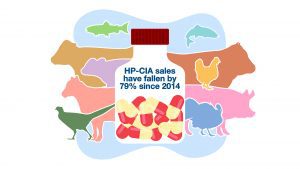
RUMA Secretary General Chris Lloyd says: ‘The UK Government set strong national reduction targets in its One Health AMR strategy. It challenged the livestock industry specifically to reduce antibiotic use by 25% between 2016 and 2020, which we surpassed and achieved voluntarily. The biggest reductions have been seen in those sectors who as higher users of antibiotics were the first to tackle the issue and have been monitoring and working on reduction strategies the longest, such as the poultry and pig sectors.’
Importantly, these achievements have been realised principally through voluntary multi-sector collaboration, which Chris says, has played a fundamental part in the reduction in antibiotic use to date: ‘UK agriculture has acknowledged the One Health challenge over the past decade and through voluntary collaboration and commitment, has driven significant change. Off the back of collaboration came the need for robust data to help inform decisions, set realistic targets and allow for progress to be monitored.’
Chris added: ‘Going forward, the challenge is to maintain the reduced levels of antibiotic use achieved whilst not negatively affecting the health and welfare of the animals we rear. Where sufficient data exists, there are plans in place to work with the higher users of antibiotics to help them reduce their use sustainably. But as we reach sustainable levels of use in some species, reduction progress will be slower, and it is important to note that the targets are not about driving towards zero antibiotic use. Antibiotics are there as a tool to treat sick animals. The removal of these tools, whether through regulation or a loss of effectiveness, could reduce the ability of a vet to respond to an animal’s clinical need. This presents a threat to the animal’s welfare. Each sector will ultimately reach a sustainable level, below which further reductions could create animal welfare issues. Maintaining these lower but sustainable levels then becomes the target.’
The importance of collaboration and data
As well as the voluntary multi-sector collaboration that has been embedded into the UK’s approach to tackling AMR, what has also become clear since the inception of the RUMA TTF infrastructure, is the crucial role that data play in both shaping the targets and defining the tactics in the journey towards achieving them. Having data to build the picture of antibiotic use for a sector is really important at two levels; nationally, it helps to show the trend of antibiotic use in the sector, and at a farm level, once data becomes available, it offers an opportunity for producers to use their medicine data as a management discussion tool. Data helps galvanise both industry activity and farm level discussions.
High levels of antibiotic data show positive progress on reductions. Data helps everyone understand where sectors are right now, usage levels, hotspots, tracking progress towards targets and helps drive informed decisions and engagement. All sectors are working hard to gather data, but there are many constraints and limiting factors which mean this will take more time in some sectors than in others. For example, where industries are bigger, more extensive and complex such as ruminant sectors, data gathering is naturally a bigger challenge and building the right data capture mechanisms is more demanding. Whereas, there are fewer limiting factors in other sectors, especially those that are more vertically aligned through their supply chains, such as pig and poultry, and comprehensive data gathering has had real, tangible and beneficial impacts on progress and engagement. A key component when data gathering is to ensure a unified approach and a common language across all sectors. In the UK, rules on data capture and language have been developed for each sector to enable consistent recording methodologies; this ensures that data is comparable within and across sectors using a consistent language.
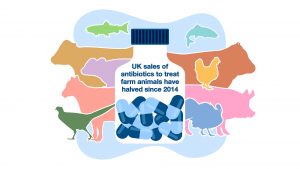
Sector initiatives
Each sector is different, with varying complexities and considerations, but each one has addressed its unique challenges using the channels available to them to encourage dialogue, awareness and ultimately change. For some, this has meant tight supply chain rules; in others, requirements in farm assurance schemes or campaigns to inform and upskill farmers (and in some cases vets) on the current best guidance for diseases and treatments. A lot of work has focused on making data capture much easier and more cohesive. The Medicine Hub (MH Medicine Hub for dairy, beef and sheep farmers), for example, was launched in 2021. It is a web-based recording system developed by the Agriculture and Horticulture Development Board (AHDB) designed to make it as easy as possible to capture data whilst avoiding duplication of effort by aligning with other record-keeping tasks. The aim of the Medicine Hub is to provide a national picture of antibiotic use and will enable comparisons across sectors. As well as the national picture, it will allow farmers and vets to understand what is going on across individual farms. At the farm level, this detail encourages all-important dialogue to help plan and prevent disease but when required, treat disease effectively using the principles of responsible use: as little as possible, but as much as is necessary and at the right time and in the right situations.
The small data sets currently available suggest the ruminant sectors are relatively low users of antibiotics, but it is hard to demonstrate that, and so the Medicine Hub will provide that all-important evidence. This will also help to reassure consumers and highlight the UK’s high health and welfare standards. The concept behind the Medicine Hub has achieved widespread support, and it is hoped this will become the primary data hub for collating existing and inputting new ruminant antibiotic usage data. One of those existing data sources is the FarmAssist Scheme (Farm Assist farmassistnml.co.uk), which captures antibiotic use for participating milk processors, vets and producers, and is an excellent resource to describe the use of antibiotics on dairy herds in Great Britain.
Alongside data collection projects, the Farm Vet Champions (Farm Vet Champions – RCVS Knowledge) initiative was also launched last year. It is a major collaborative project designed to unite and empower UK farm animal veterinary practitioners as they establish good antimicrobial stewardship in practices and on farms. The project has brought together the specialised veterinary and agriculture organisations to develop free learning materials for farm veterinary professionals to improve animal health and welfare standards and provide positive inspiration and leadership towards antimicrobial resistance (AMR). The project encourages agricultural veterinary professionals to improve their knowledge, but to also set personal SMART objectives, which may link across the vet practice and its client base to promote best practice in medicine use whilst ensuring welfare standards.
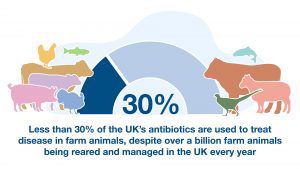
Finally, there is the Government Animal Health Pathway which gets underway this year. It is one of a number of new Post Brexit farm policy and support initiatives and represents a new and fresh way to support farmers and vets to come together and tackle the disease challenges on the farm. Involving farm health plans and diagnostics to understand underlying issues it will help build closer working relationships between vets and farmers and identify the specific disease challenges on farms. The anticipated benefits of health and welfare improvements on farms include the potential reduction of the need for antibiotic treatments and benefitting the government’s productivity strategy, as healthy animals are productive animals.
When it comes to the development of rapid diagnostics in agriculture, which was an area that was identified for further exploration by the O’Neill Report, promising work is underway, and RUMA would expect to see some of these new technologies at the vet practice level as the first step in the future.
The journey ahead
What has been achieved to date has been incredible and has been done so largely voluntarily without added regulation – testament to the commitment right across the UK livestock industry in delivering the highest standards of food safety, animal health and animal welfare.
Chris added: ‘The key learnings from the first set of targets, most notably the importance of data which remains a critical component, have helped shape the creation of the second set of targets. But it is the continued willingness and commitment across UK agriculture to drive positive and sustainable change that is the key factor – data would mean nothing if there was not a will to use it and adapt. Learnings will continue to be applied moving forwards to ensure informed, evidence-based decision-making is applied across all aspects of RUMA TTF activity.’
Of particular note is the acknowledgement that achieving zero use of antibiotics is neither possible nor appropriate across any sector. There will come a tipping point where the journey of reduction changes, and becomes focused on maintaining responsible levels of use rather than pushing antibiotic use so low that the repercussions would actually be detrimental.
The future scope and opportunities for UK medicines legislation is also being considered by the Veterinary Medicines Directorate (VMD) this year to assess the regulatory landscape and create legislation that meets the UK’s needs, is ‘fit for purpose’ and continues to deliver the high standards of food quality and animal welfare for which the UK is recognised.
For more information about the work of RUMA, visit ruma.org.uk
References
- https://www.ruma.org.uk/
- https://amr-review.org/sites/default/files/160525_Final%20paper_with%20cover.pdf
- https://www.ruma.org.uk/wp-content/uploads/2020/11/SO-469-RUMA-REPORT-021220.pdf
- https://www.gov.uk/government/publications/veterinary-antimicrobial-resistance-and-sales-surveillance-2019
Chris Lloyd
RUMA Secretary General
Mary Bawn
RUMA Communications Manager
This article is from issue 21 of Health Europa Quarterly. Click here to get your free subscription today.










